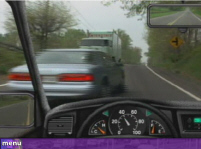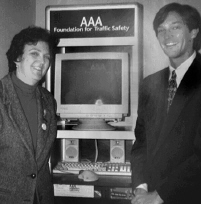|
Teenage
drivers crash more
A review of
licensing for teens
By Karen Wims

Photo by Chris Johnson
|
The AAA Foundation’s driver-ZED computer
program gives teen drivers
a chance to test their skills.
|
 Photo
by Mary M. Ford
Photo
by Mary M. Ford
|
Stephanie Faul and Chris Johnson demonstrate
the
AAA Foundation for
Traffic Safety's driver-Zed computer
driver training.
|
|
Automobile
crashes are the number one killers of teens—accounting for more than 5,000
deaths per year. According to the National Highway Traffic Safety Administration,
a 16-year-old driver is 42 percent more likely to be involved in a crash
than a 17-year-old with just one additional year of driving experience.
In addition, 16-year-old drivers were involved in 10,337 crashes per
100,000,000 vehicle miles of travel. The rate for 17-year-olds was just
3,229. These are alarming statistics when 41.8 percent of 16-year-olds
hold a driver's license.
Other countries and many states have enacted graduated license laws
with some success. Restrictions may include six months of crash-free, conviction-free
driving, zero tolerance for alcohol, no driving between midnight and 6:00
a.m. without authorization, provisional color-coded drivers' licenses,
and successful completion of a driver education course.
Driver-Zed program a hit
The driver-ZED program developed by AAA Foundation for Traffic Safety
(AAAFTS) uses realistic traffic situations to help teens spot risks. This
program has met an enthusiastic response, according to Christopher Johnson,
a research analyst at AAAFTS. "The students who go through this program
have found it to be very helpful in real time driving situations," he says.
Parents can also take steps to help prevent or reduce the number of
crashes involving teen drivers. Parents should:
-
supervise their teen's driving time;
-
give the teen supervised practice behind the wheel while he or she has
a learner's permit and throughout the first year of licensed driving;
-
put a limit on the number of passengers allowed in the car;
-
limit the teen's driving during periods of increased risk such as weekends;
-
establish a house curfew;
-
insist that the teen and any passengers wear safety belts;
-
set limits on the areas the teen can drive;
-
prohibit the teen from driving under the influence of drugs or alcohol;
-
encourage the teen to use good judgment both as a driver and as passenger;
-
and be a good role model.
Unfortunately, none of these suggestions totally safeguards against crashes
by teen drivers, but their practical application may prevent injury or
death to teens and others.
|

